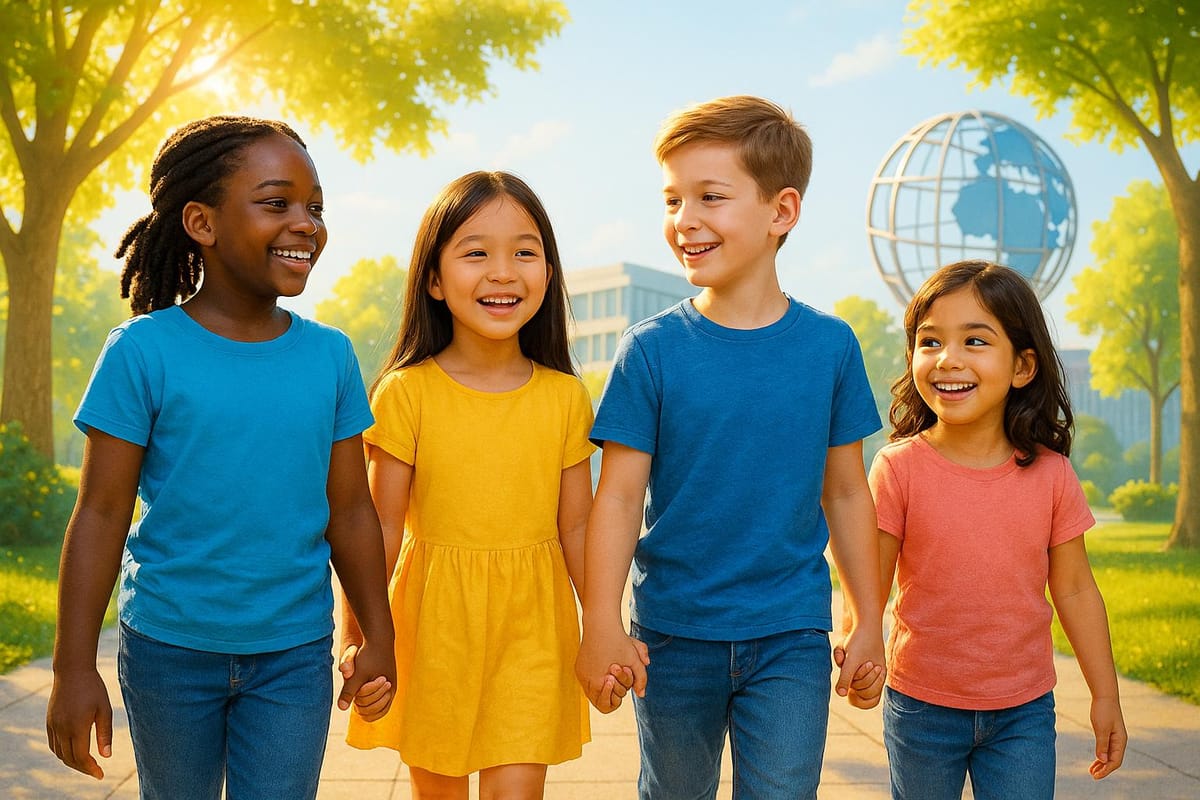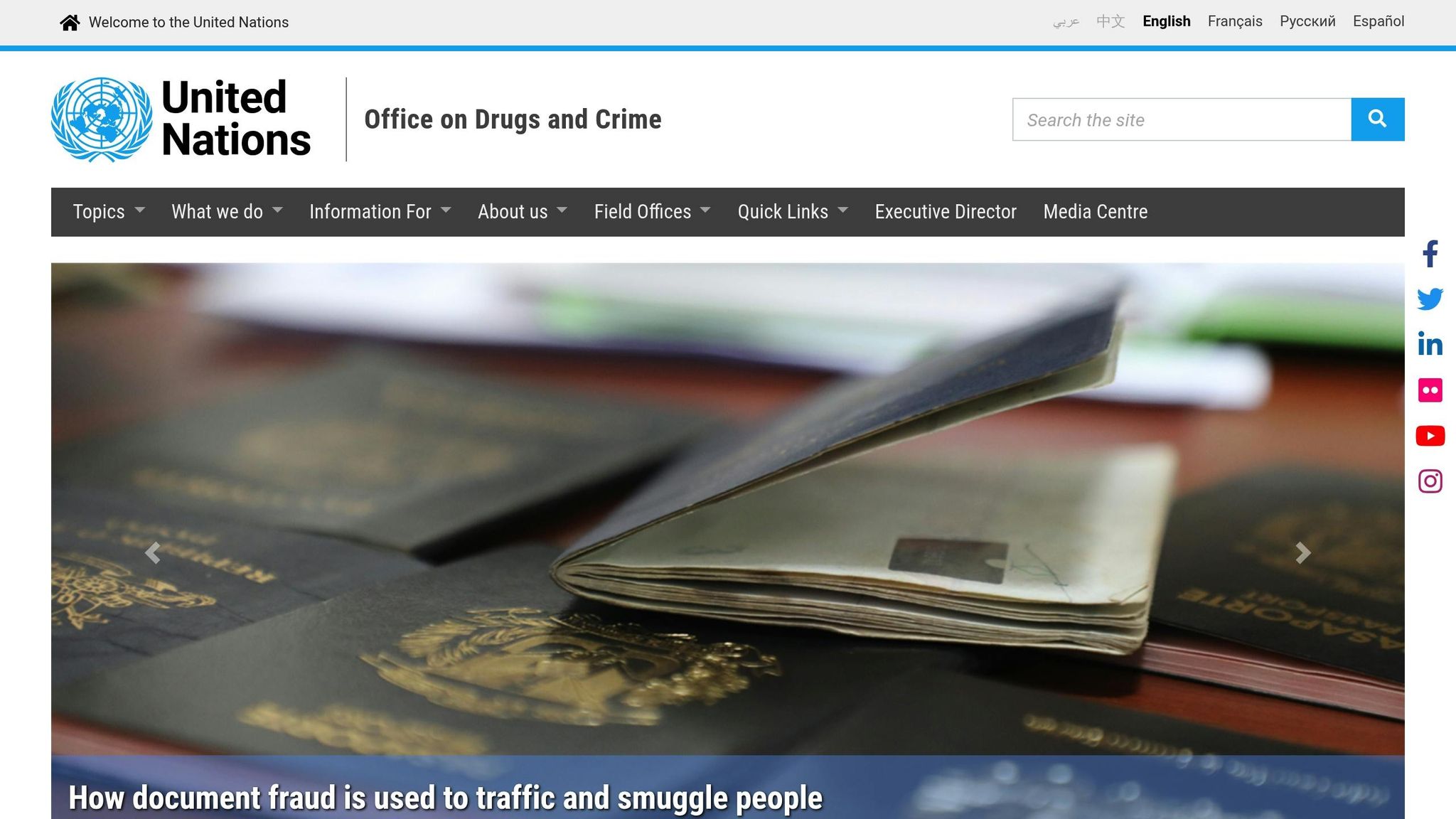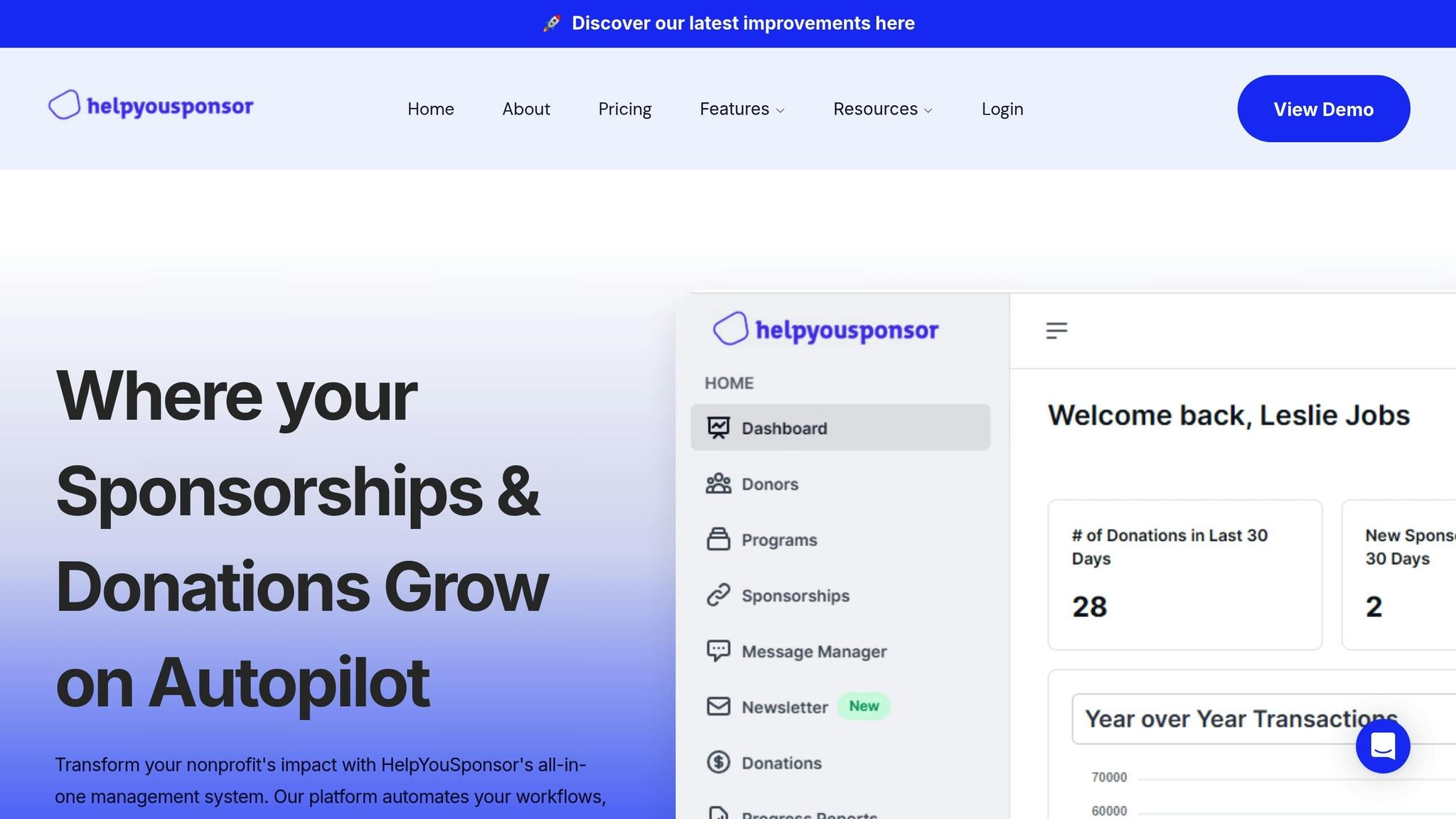UN Protocols on Child Trafficking Explained
Explore the UN Trafficking Protocol's comprehensive framework to combat child trafficking, focusing on prevention, protection, and prosecution.

Child trafficking is a global crisis affecting millions, with children making up 38% of all trafficking victims. The UN Trafficking Protocol is the key international agreement addressing this issue. It defines trafficking, sets legal standards, and outlines a three-part approach: prevention, protection, and prosecution. Here's what you need to know:
- Definition: Trafficking involves recruiting, transporting, or exploiting children, and does not require proof of coercion for minors.
- Key Stats: In 2020, 20,000 children were identified as victims, though actual numbers are likely much higher. Forced labor and sexual exploitation are the most common forms.
- Global Commitment: As of 2025, 185 countries have ratified the Protocol, committing to criminalize trafficking, protect victims, and collaborate internationally.
Despite this framework, enforcement gaps, resource shortages, and evolving trafficking methods continue to pose challenges. Nonprofits and governments must work together to strengthen protections, improve cross-border cooperation, and address root causes like poverty and inequality.
The Protocol provides a roadmap, but real progress requires coordinated action from all sectors.
20 Years of the UN Trafficking in Persons Protocol
Key Provisions of the UN Trafficking Protocol
The UN Trafficking Protocol lays out a detailed framework designed to address child trafficking through prevention, protection, and prosecution. These provisions aim to tackle the issue from multiple angles, ensuring a holistic response.
The 3 Pillars: Prevention, Protection, and Prosecution
The Protocol's foundation rests on three core pillars that guide efforts to combat child trafficking.
Prevention emphasizes stopping trafficking before it happens. States are required to address the root causes, such as poverty and inequality, through targeted policies. This includes conducting research, raising public awareness, and implementing socio-economic programs to diminish vulnerabilities that traffickers exploit.
Protection focuses on supporting child victims. The Protocol mandates that states offer age-appropriate housing, education, and care. It also requires safeguarding victims' privacy, providing clear legal guidance, and creating pathways for compensation. The goal is to ensure that children receive the specialized attention they need to recover and rebuild their lives.
Prosecution ensures traffickers face legal consequences. States are obligated to criminalize all trafficking activities, including attempts, complicity, and organizing trafficking offenses. This pillar ensures accountability and serves as a deterrent to future crimes.
Definition of Trafficking and Legal Standards for Children
One of the Protocol's key achievements is the establishment of the first internationally recognized, legally binding definition of human trafficking. This serves as a critical tool for identifying victims and ensuring their protection.
The Protocol defines trafficking in persons as:
"The recruitment, transportation, transfer, harboring or receipt of persons, by means of the threat or use of force or other forms of coercion, of abduction, of fraud, of deception, of the abuse of power or of a position of vulnerability or of the giving or receiving of payments or benefits to achieve the consent of a person having control over another person, for the purpose of exploitation."
For adults, trafficking is proven by demonstrating three components: the act (e.g., recruitment or transportation), the means (e.g., coercion or deception), and the purpose (exploitation). However, for children under 18, the "means" element is not required. Any act involving the recruitment, transportation, harboring, or receipt of a child for exploitation automatically qualifies as trafficking, even without evidence of coercion.
This distinction is critical in practice. For example, in 2022, victims from 162 nationalities were trafficked to 128 countries, with 31% of cross-border trafficking victims being from Africa. The Protocol's definition of exploitation includes a wide range of abuses, such as sexual exploitation, forced labor, slavery, servitude, and organ removal. This broad scope ensures that various forms of exploitation are addressed under international law.
Obligations of Ratifying States
As of July 2025, 185 parties have ratified the Protocol, committing to a range of legal and practical measures aimed at combating trafficking. These obligations are designed to create a cohesive and effective international response.
Legislative Harmonization: States must align their domestic laws with the Protocol's definition of trafficking. This includes criminalizing all trafficking activities, such as attempts, complicity, and organizing trafficking operations.
Victim Protection and Assistance: Ratifying states are required to provide comprehensive support for child victims, including housing, education, counseling, and medical care. Recovery programs should also offer opportunities for employment and training, ensuring victims' safety and access to compensation for the harm they’ve endured.
Cross-Border Cooperation: Given the international nature of trafficking, states must facilitate the safe repatriation of victims, particularly children, while ensuring their safety throughout the process.
Prevention Measures: States are encouraged to strengthen border controls, secure travel documents, and address the demand for exploitation. Training for officials on trafficking prevention, victim protection, and prosecution is also a crucial element.
The Protocol underscores these commitments with the following mandate:
"The Protocol commits ratifying states to prevent and combat trafficking in persons, protecting and assisting victims of trafficking and promoting cooperation among states in order to meet those objectives."
Implementation and Monitoring of the Protocol
Turning the Protocol’s commitments into tangible results requires effective implementation and rigorous monitoring. With 182 parties ratified as of March 2025, ensuring coordinated oversight is essential. To make these commitments actionable, international agencies have stepped in to play critical operational roles.
Role of the United Nations Office on Drugs and Crime (UNODC)

The UNODC is at the forefront of translating the Protocol's goals into action. It provides technical support, builds capacity, and assists states in creating anti-trafficking laws, training officials, and setting up victim protection systems. A key focus is on developing child-friendly justice guidelines to help trafficked children recover from trauma. Additionally, the UNODC examines case law to offer guidance on effective investigation, prosecution, and sentencing practices. To ensure a cohesive global response, the agency also leads the Inter-Agency Coordination Group against Trafficking in Persons.
"It is the first legally binding instrument with an internationally recognized definition of human trafficking. This definition provides a vital tool for the identification of victims, whether men, women or children, and for the detection of all forms of exploitation which constitute human trafficking."
Cross-Border Cooperation Mechanisms
Recognizing that trafficking networks often span multiple countries, the Protocol emphasizes international cooperation. States are encouraged to adopt several mechanisms:
- Information exchange systems: Establish direct communication channels between border control agencies to share intelligence effectively.
- Joint training programs: Standardize responses among law enforcement, immigration officials, and other stakeholders through collaborative training.
- Border security measures: Implement enhanced screening and document verification procedures to disrupt trafficking networks.
- Document security improvements: Strengthen controls to prevent the misuse of travel documents.
These measures create formal pathways for states to collaborate in preventing trafficking, prosecuting offenders, and safeguarding victims. The Protocol’s preamble underscores the need for a comprehensive approach:
"Effective action to prevent and combat trafficking in persons, especially women and children, requires a comprehensive international approach in the countries of origin, transit and destination that includes measures to prevent such trafficking, to punish the traffickers and to protect the victims of such trafficking, including by protecting their internationally recognized human rights."
In addition to fostering collaboration, robust data collection is critical for evaluating and refining these efforts.
Data Collection and Reporting Requirements
Accurate and systematic data collection is essential for tracking the Protocol's progress. States are tasked with developing national data systems to capture detailed information on trafficking cases, including victim demographics and prosecution outcomes. Secure data sharing across key agencies is also vital. To support this, personnel must be trained in secure data handling, enabling the analysis of trends that inform anti-trafficking strategies. Regular international reporting further facilitates the exchange of best practices.
This monitoring framework strengthens the Protocol’s mission to protect vulnerable populations and hold traffickers accountable. Hans Leijtens, Executive Director of Frontex, highlighted the moral responsibility behind these efforts:
"Child trafficking is not just a legal problem. It is a moral one. And we have a duty to act."
This ethical obligation drives practical actions, such as increasing Frontex’s presence at critical border points and enhancing officer training to identify exploitation.
Challenges in Global Enforcement
The UN Trafficking Protocol provides a solid framework, but turning its principles into action remains a tough challenge. Enforcement gaps across the globe continue to weaken efforts to protect children and hold traffickers accountable. Below, we dive into the specific obstacles that hinder effective cross-border enforcement.
Common Obstacles to Implementation
One of the biggest issues is the lack of a reliable enforcement mechanism within the Protocol itself, which has led to inconsistent application among nations.
Another critical problem is inadequate funding and staffing. Anti-trafficking initiatives often remain reactive rather than proactive due to limited resources. This issue is especially severe in areas with restricted access to advanced technology. In such regions, law enforcement agencies frequently lack the tools needed to counter increasingly sophisticated trafficking networks.
The numbers paint a stark picture. In 2020, it took an average of 38 months to resolve a federally prosecuted sex trafficking case in the U.S.. Political will also varies significantly between countries, with some failing to establish dedicated task forces or allocate sufficient manpower to combat trafficking effectively.
Meanwhile, traffickers are leveraging digital tools at an alarming rate, yet government investment in anti-trafficking technology remains strikingly low. Out of 305 available tools designed to combat trafficking, only 9% are funded by governments.
Beyond these domestic hurdles, international enforcement faces an entirely different set of challenges.
Cross-Border Enforcement Challenges
When it comes to international cooperation, a host of unique obstacles can derail enforcement efforts. Language and cultural differences between law enforcement officers and victims often give traffickers an edge, helping them hide their crimes. Jurisdictional issues also complicate matters; trafficking networks that operate across multiple countries make it difficult to determine which authority should lead investigations and prosecutions. On top of that, lengthy extradition processes and legal hurdles in sharing evidence can significantly delay investigations.
Another issue is the uneven training of law enforcement personnel across nations. Many officers lack the specialized training needed to identify trafficking victims or understand the complexities of human trafficking, leading to missed opportunities for intervention.
The scale of the problem underscores the need for better coordination. Human trafficking generates between $32 billion and $150 billion annually, making it the third-largest criminal industry after arms and drug trafficking. Each year, over 2 million children are exploited through child sex tourism.
Efforts to combat trafficking must also strike a balance between aggressive enforcement and safeguarding human rights. International guidelines stress that anti-trafficking measures should not harm the rights or dignity of trafficking victims - or other vulnerable groups such as migrants, refugees, and asylum seekers. In countries with weak criminal justice systems, overly broad definitions of trafficking can complicate investigations and prosecutions, making the work of front-line investigators even harder.
Best Practices for Nonprofit Organizations
Nonprofit organizations play a vital role in supporting government efforts to combat trafficking, especially when it comes to protecting vulnerable children. To make a meaningful impact, these organizations need to align their work with the UN Trafficking Protocol and focus on advocacy and operational improvements. Below are some actionable steps nonprofits can take to put these legal standards into practice.
Developing Child Protection Policies
Effective anti-trafficking strategies begin with clear and comprehensive policies. According to Article 3 of the UN Trafficking Protocol, trafficking includes any act of recruitment, transportation, or harboring of a child for exploitation. For organizations working with children, this means their policies must address every aspect of this definition.
Your policies should incorporate the Protocol's three key pillars: identifying trafficking situations, protecting victims' rights, and collaborating with law enforcement when necessary. Training programs for staff are essential to ensure these policies are implemented effectively. Article 10 emphasizes the importance of equipping law enforcement and other relevant personnel with the skills to recognize trafficking, understand legal frameworks, and respond appropriately.
"Effective action to prevent and combat trafficking in persons, especially women and children, requires a comprehensive international approach...that includes measures to prevent such trafficking, to punish the traffickers and to protect the victims of such trafficking, including by protecting their internationally recognized human rights."
Organizations must also prioritize privacy and identity protection for victims, as outlined in Article 6. This includes secure data handling practices, confidentiality protocols, and limiting access to sensitive information about children in their care.
In addition to these measures, addressing the root causes of trafficking is crucial. Article 9 encourages efforts to tackle vulnerabilities such as poverty and lack of opportunities. Programs that strengthen families and communities - through education, economic support, and social services - help to reduce the conditions that make children susceptible to trafficking.
Using Tools like HelpYouSponsor

To align with international anti-trafficking standards, child sponsorship programs need strong data management systems. This is where platforms like HelpYouSponsor can make a difference.
HelpYouSponsor provides tools designed to securely track children’s information while ensuring transparency. Features like role-based access controls and customizable admin permissions safeguard sensitive data while allowing authorized staff to monitor program activities. These measures align with the Protocol’s privacy and identity protection requirements.
The platform also offers advanced tracking capabilities, allowing nonprofits to maintain detailed records of children, sponsor relationships, and fund allocations. This level of documentation is critical for spotting unusual patterns that could indicate exploitation. Integration with tools like Salesforce and Zapier helps streamline operations while preserving data integrity.
"Child sponsorship changes lives. With HelpYouSponsor, we can focus on our mission instead of paperwork. It's helped us reach more children and engage our donors in meaningful ways." - Diana Scimone, Born2Fly
Automation is another key benefit. HelpYouSponsor can handle up to 90% of sponsorship management tasks, freeing up staff to focus on child protection and program oversight. Organizations using the platform have reported a 3.8x increase in sponsorships, translating to more resources for child-focused initiatives.
Additionally, the platform’s financial transparency features ensure accountability. With clear reporting and donation tracking, nonprofits can quickly identify and address any irregularities, meeting the expectations of both donors and regulatory bodies.
Building Partnerships and Capacity
Collaboration with governments and international organizations is essential for addressing the global challenges of trafficking. Article 4 of the Protocol encourages partnerships between civil society organizations and government agencies to strengthen anti-trafficking efforts. Nonprofits can leverage these partnerships to enhance oversight, share resources, and amplify their impact.
For example, UNICEF supports multi-purpose centers in Ecuador that protect refugee and migrant children from trafficking risks. These centers provide safe spaces, psychological support, and legal assistance. Nonprofits can replicate such models by working with local organizations and government bodies to expand their reach.
Investing in training and development across your network is another important step. Organizations like Unseen have demonstrated the power of collaboration, working with 37 partner groups to serve over 100,000 people in 33 countries. Training partners in areas like fundraising and program management helps them grow their capacity and extend their impact.
Advocacy is equally important. Pushing for stronger laws that increase penalties for traffickers and enhance victim protections is critical. In 2023 alone, trafficking generated an estimated $236 billion, yet only 19,000 prosecutions and 7,000 convictions were reported globally. Clearly, there’s room to improve enforcement mechanisms.
"We believe communities can only flourish when every person is treated with respect and dignity. Addressing injustices like labor trafficking and sexual exploitation is aligned with our values of creating resilient communities where every person can thrive." - Rebecca Hixon, N2 director of philanthropy
Finally, nonprofits should integrate anti-trafficking measures into crisis response strategies. Vulnerable populations, especially children, face heightened risks during crises. Proactively identifying and protecting at-risk children can prevent them from becoming victims.
With one in four trafficked individuals being a child, the work of child-focused organizations is essential. Through prevention, protection, and advocacy, nonprofits are making a real difference in reducing this troubling statistic. Their efforts are a critical part of the global fight against trafficking.
Conclusion and Key Takeaways
Summary of Key Provisions and Challenges
The UN Trafficking Protocol has been a cornerstone in the fight against child trafficking for over two decades, offering a clear definition of child trafficking and outlining obligations that have shaped global efforts. At its core, the Protocol emphasizes prevention, protection, and prosecution, defining any recruitment or harboring of a child for exploitation as trafficking - a critical legal distinction.
However, the challenges remain daunting. Children now account for 38% of all trafficking victims detected globally. Between 2019 and 2022, global detections of trafficking increased by 25%, with girls alone making up 38% of victims. This troubling trend highlights the growing vulnerability of children to trafficking, as Dr. Najat Maalla M'jid, the UN Special Representative on Violence against Children, noted:
"Despite a lot of progress achieved in legislation, policy and practices, trafficking in children continues to increase, because the responses are not evolving quickly enough to keep pace with the evolution and scale of the crime."
Traffickers are constantly adapting, exploiting technological advances and vulnerabilities created by crises like war, climate change, and restrictive migration policies. Compounding the problem is the lack of consistent reporting and prosecution of trafficking cases, which allows these crimes to flourish.
These challenges make it clear that more needs to be done to protect children and bring traffickers to justice.
How Organizations Can Make a Difference
Nonprofits have a crucial role in addressing these challenges, acting as vital connectors between vulnerable communities and institutional responses. The Protocol emphasizes the importance of collaboration with civil society organizations to create comprehensive anti-trafficking policies. With nearly 50 million people affected by trafficking and related exploitation worldwide, the urgency for action cannot be overstated.
To be effective, nonprofits must combine tried-and-true methods with modern technology. Strong child protection policies are a must, but these need to be bolstered by advanced data management systems that ensure effective monitoring while safeguarding privacy. Tools like HelpYouSponsor exemplify this approach, streamlining protection efforts so organizations can allocate more resources to direct interventions.
"Ending child trafficking is possible if Member States and other stakeholders mitigate their vulnerabilities, invest in proactive prevention and sustainable protection, reduce children's vulnerabilities and strengthen accountability to end impunity of traffickers, buyers, sellers, and intermediaries."
The most impactful organizations tackle systemic vulnerabilities by partnering with government agencies, implementing community-driven prevention programs, and advocating for stricter enforcement measures. With one in three trafficking victims being a child, every nonprofit working with at-risk populations has a responsibility to contribute to prevention and protection efforts.
The Protocol’s vision of unified international cooperation is as relevant today as ever. For nonprofits, this means building strong internal systems, leveraging effective tools and partnerships, and staying laser-focused on protecting children who are counting on robust safeguards. While the obstacles are significant, aligning with international standards offers a pathway to meaningful change.
FAQs
What are the biggest obstacles to enforcing the UN Protocol on child trafficking globally?
Enforcing the UN Protocol on child trafficking comes with a host of challenges. One of the biggest hurdles is the lack of consistent international collaboration. Different countries operate under varying legal frameworks, have unique priorities, and possess unequal resources. These differences make it tough to coordinate efforts and share vital information across borders effectively.
Another significant obstacle is proving force, fraud, or coercion, which are crucial elements in many trafficking cases. Collecting enough evidence to meet legal requirements can be incredibly complicated, especially when victims are hesitant to testify or lack proper documentation.
On top of that, disagreements about the interpretation of the protocol's language further complicate enforcement. The issue is often muddied by debates over how trafficking is defined, especially when it overlaps with other topics like sex work. These combined factors create roadblocks to establishing a cohesive global strategy to tackle child trafficking.
What is the difference between child and adult trafficking under the UN Trafficking Protocol?
The UN Trafficking Protocol makes a clear distinction between child trafficking and adult trafficking, primarily based on the victim's age. According to the protocol, anyone under the age of 18 is considered a child. In cases involving children, consent is not a factor when exploitation, such as child sex trafficking, occurs. This is because minors are not legally capable of giving consent.
For adults, trafficking cases require evidence of factors like coercion, deception, or abuse of power. An adult's consent might be evaluated depending on the situation. This differentiation is designed to provide children, who are particularly vulnerable, with stronger legal protections against trafficking and exploitation.
How do nonprofit organizations contribute to the UN's efforts to combat child trafficking, and how can they improve their impact?
Nonprofit organizations are key players in supporting the objectives of the UN Trafficking Protocol. They contribute through legal assistance, protective services for survivors, prevention programs, and awareness campaigns. These initiatives tackle the multifaceted issue of child trafficking across both local and international landscapes.
To make an even greater impact, nonprofits can prioritize partnering with governments and other groups, engaging local communities to build grassroots advocacy, and offering specialized training for their teams. These actions strengthen their ability to fight trafficking and provide substantial support to those affected.

